Slovakia
There is not much spoken and written about Slovakia. Not so much that it is even confused with Balkan Slovenia - a tiny and little-known country. And this fact is really disappointing.
Those who have been to Slovakia always talk about this paradise in the centre of Europe being undervalued. The Slovak mountain ski resorts, national parks, caves, and castles are not worse than the hyped tourist meccas. And the cost of spending a vacation there costs many more times cheaper.

General Information
Slovakia gained its independence in 1993 when Czechoslovakia as a socialist Central European country ceased to exist. The Velvet Divorce occurred in a civilized way, so soon two newly-formed republics took on lives of their own.
At present, Slovakia is a little behind its ‘counterpart’, the Czech Republic, in economic development. However, in general, it is considered one of the most dynamically developing young EU states. It has been the EU member state since 2004 with the euro as the official currency.
To enter the territory of the Slovak Republic, a Schengen visa is needed.
Automobile manufacturing, electrical engineering, and agriculture are well-developed industries. Unique natural settings have contributed to opening beautiful mountain ski resorts and related infrastructure. However, this potential needs to be assessed in more detail.
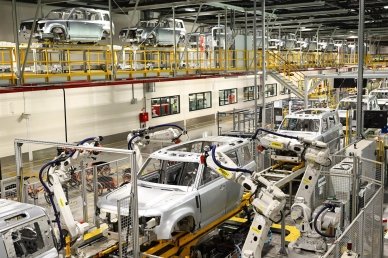
Jaguar Land Rover plant in Nitra, Slovakia.
Annually, around two million tourists come to Slovakia. Though they are predominantly from the neighbouring countries (the Czech Republic, Germany, and Poland), the horizons are gradually extending. Not only Europeans are exploring Slovakia, but also tourists from the other continents.
Slovakia is a small country with a population of 5.5 million people. There is not any city with a million-plus population. Even the capital and the biggest city, Bratislava, has 430,000 residents. Košice is the second-largest city with more than 230,000 people who live there. The other cities do not have even 100,000 residents.
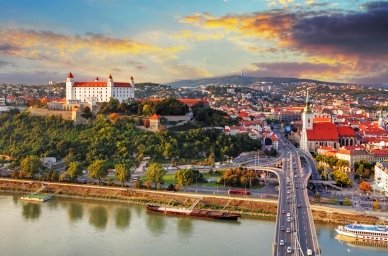
Bratislava, Slovakia
As well as the other Visegrád Group member states, this country is mono-ethnical. More than 85% of its citizens are Slovaks and speak the Slovak language. The biggest ethnic minority involves Hungarians, who constitute approximately 10% of the country’s population and inhabit the southern part of the country.
In the Slovak towns and villages where minorities live, the Hungarian language holds a co-official status.
The climate in Slovakia is mild. Winters are usually cold but with little snow, and summers are warm but with frequent rains.
Directions
There are organised tours to Slovakia from all neighbouring countries - the Czech Republic, Poland, Hungary, Austria, and Ukraine. Bus tours are the most popular among them.
Travelling by Bus
Slovakia is among the European countries where the interstate bus network is well-developed. So it is possible to get to Bratislava and other cities from many points in Europe.
The most popular international routes to Slovakia are from Vienna, Belgrade, Budapest, Uzhhorod, Zagreb, Prague. etc.
Bratislava is the only European capital located not in the centre of the country, but close to the border between Austria and Hungary.
Travelling by Train
To get to Slovakia from Western Europe, Prague or Vienna railway stations are the best options. There is also a railway connection between Kyiv and Bratislava.
Travelling by Plane
This is the best option when you do not have time for long journeys. Bratislava International Airport is operated by such airlines as Wizz Air, Ryanair, SkyUp, etc. There are regular and charter flights to and from different parts of Europe.

Accommodation
Tourism in Slovakia is highly developed, so the choice of hotels is very extensive. The prices are similar to the Hungarian ones, and the quality of service is very good.
Below are several budget hotels in Bratislava and mountain ski resorts where a comfortable rest is provided:
- Hilson Jasna - Garden resort is a four-star hotel for family holidays at the Jasna Mountain Ski Resort. The rooms are quite good with a bathroom in each. The food served is delicious. Besides, there are children’s playgrounds and pistes nearby. It will take five minutes to get to Demänovská Cave of Liberty.
- Ubytovanie Zencuch is a small hotel in Drienica, a mountain ski resort in eastern Slovakia. The rooms are small but clean and with a bathroom in each.
- Ibis Bratislava Centrum is a three-star hotel located in the historical centre of the Slovak capital. There are Bratislava Castle (Bratislavský hrad), Old Town Hall, and the Blue Church nearby. The rooms have air-conditioning and baby cots. Breakfasts are not free.
- Hostel ZERO is a budget hostel in the historical centre of Bratislava. There are many attractions, cafes, and bars nearby. The showers and rooms are clean. Air-conditioning is also provided. The hostel is perfect for youths.
- City Center Best Place Apartments is a budget hotel in the very centre of the city. There is everything needed for a good sleep and rest. The rooms are furnished in a comfortable way. And kitchenettes are available as well.
Renting an apartment on a daily or monthly basis in Bratislava, Košice, and at the mountain ski resorts is also very popular among tourists.
Living conditions are always good, but the price varies by the remoteness of an apartment from the city centre or pistes: the closer to the centre or a piste, the higher the cost.
Places to See
Though Slovakia is a small state, there is a multitude of sightseeing attractions. They include castles (Slovaks call them ‘hrads’), mountain caves, the High Tatras resorts, beautiful lakes, national parks, and just other stunning corners of the country.
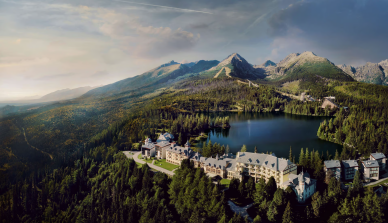
Grand Hotel Kempinski High Tatras
It is not necessary to make up the top list because each of those places is worth being called the best. Below are some of them:
Bratislava Castle (Bratislavský hrad) is a carte de visite of Slovakia. This place also houses the Parliament and the Historical Museum. It used to be a part of fortification on the border of the Roman Empire. Then its boundaries were extended when the kings chose the castle to seat in. Later there were times of neglect and decay until 1953 when the reconstruction works began. Bratislavský hrad is under restoration even up to these days.
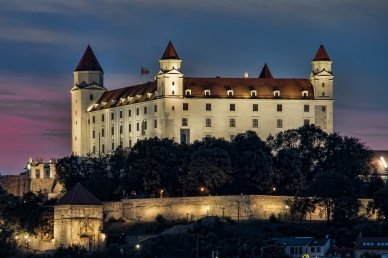
Bratislava Castle (Bratislavský hrad)
Devin Castle (Devinsky Hrad) is the ruins of one of the oldest Slovak castles built several millennia ago. It is located a 15-kilometre bus ride from Bratislava. When it is warmer outside, you may get to the castle by boat. It will be a magnificent place where Austria and Little Carpathians are visible in full view from the unbroken towers.
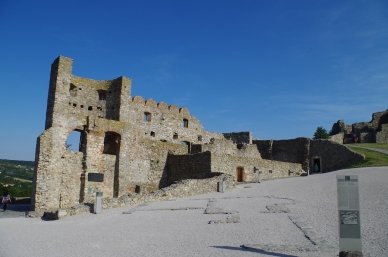
Devin Castle (Devinsky Hrad)
Trenčín is a small and cosy city located 120 km from Bratislava. Great interest is evoked by Trenčín hrad - the third largest old castle in Slovakia. The site has been perfectly kept, and now the castle houses the city museum.
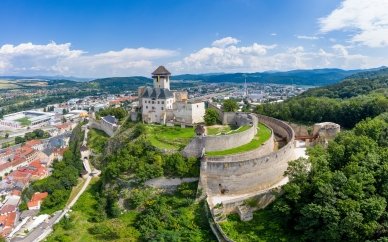
Trenčín hrad
Jasovská Cave is a mandatory route for everyone fond of spelaeology. There are stalactite caves and secret underground passages once used by the monks of a neighbouring monastery. At present, the guided tours are held only for a short distance of 720 metres. Interestingly, the halls of this cave are located at various heights, and differences may be up to 30 metres.
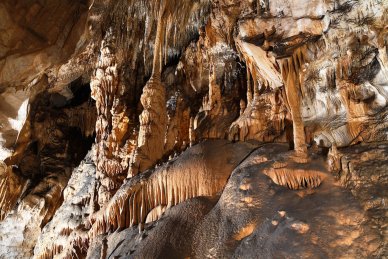
Jasovská Cave
Tatralandia Waterpark can be regarded as the best place for youth celebration or child’s birthday party. The 40-acre park operates all year round. There are 11 pools with mineral water from relic springs where people from entire Europe come to have rest or undergo treatment.
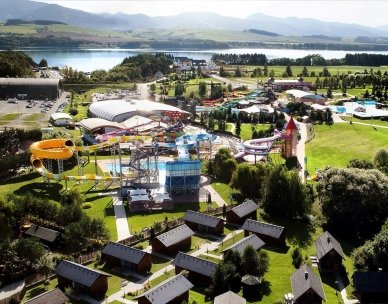
Tatralandia Waterpark
Apart from the above-mentioned places, visitors to Slovakia adore spectating the picturesque nature of Tatra National Park, Dobšiná Ice Cave, and one of the most beautiful European lakes - Štrbské pleso.
Food
The Slovak cuisine is tasty, filling, and plain. It cannot be called very unique because the cooking habits and tastes have been affected by the neighbouring nationalities. Nonetheless, there are some dishes worth being tried when in Slovakia:
- Goulash stems from Hungary but has been deeply rooted in Slovak cuisine. It is a thick soup with beef, potatoes, and knodel (or dumplings). In comparison with its Hungarian counterpart, goulash in Slovakia is never too spicy, just tasty and filling.
- Bryndzové halušky has Italian roots in Slovak cuisine. Halušky are similar to gnocchi and are made of unusual dough that consists of potatoes and flour. The dough is then boiled and served with bryndza and fried pork bits.
- Kapustinica (sauerkraut soup) is a traditional Christmas dish in every Slovak family. It is a very thick soup with short ribs, vegetables, and sauerkraut. To get a dish flavourful, they often add sausages and serve it in a bread bowl.
- Roasted pork knuckle is a dish cooked not only in Slovakia but in the Czech Republic and Germany. The pork knuckle is first boiled and then roasted in honey-beer sauce with herbs. This giant serving of tender meat will be enough for three strong men.
- Strudel is the number one dessert in Slovakia and the Czech Republic and has roots in Austrian cuisine. It is cooked from the thin puff pastry with the big fruit filling - be it chopped apples, cherries, or berries. Strudel is often served with a cup of coffee, ice cream, and whipped cream.
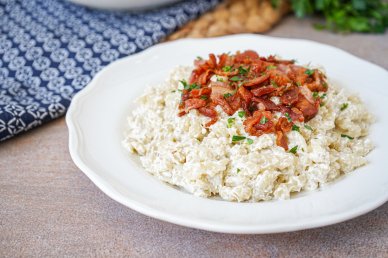
Bryndzové Halušky (Slovak Potato Dumplings with Cheese)
The favourite booze here is beer. According to statistics, an average Slovak may drink up to five glasses in one Friday evening.
And if everything goes smoothly and more fun is needed, they will enjoy borovička - a locally manufactured vodka, a kind of juniper liquor.
Among soft drinks, Slovaks prefer kofola - a coffee-syrup beverage flavoured with fruit and berry juices. It tastes like Coke but is not so sweet and consists of solely natural ingredients.
Though small, Slovakia is a magnificent country. It is a bright discovery for everyone willing to get acquainted with Europe. Come here to make sure this is absolutely true.
FAQ
What country was Slovakia before?
Before becoming an independent nation in 1993, Slovakia was part of Czechoslovakia, which was formed in 1918.
Is Slovakia a large country?
Slovakia is not a large country. It is a small landlocked country in Central Europe, covering an area of about 49,035 square kilometers.
What is the population of Slovakia?
The population of Slovakia is approximately 5.5 million people.
What is the official language of Slovakia?
The official language of Slovakia is Slovak.
What is the main religion of Slovakia?
The main religion in Slovakia is Roman Catholicism.
Is Slovakia a member of the EU?
Yes, Slovakia is a member of the European Union.
Is Slovakia in the euro?
Yes, Slovakia uses the euro as its currency.
Is Slovakia still a communist country?
No, Slovakia is not a communist country. It transitioned to a parliamentary democratic republic after the Velvet Revolution in 1989 and the subsequent split of Czechoslovakia in 1993.
What type of government is Slovakia?
Slovakia has a parliamentary democratic government. The President is the head of state, and the Prime Minister is the head of government.
Is Slovakia a rich or poor country?
Slovakia is considered a high-income, developed country, but it is not as wealthy as some of its Western European counterparts.
What is Slovakia famous for?
Slovakia is famous for its stunning mountain landscapes, including the Tatra Mountains, historic castles and medieval towns, folk traditions, and its central location in Europe.
Is Slovakia a good place to live?
Slovakia is considered a good place to live, known for its natural beauty, historic cities, and relatively low cost of living. However, like any country, the quality of life can vary depending on personal circumstances and location within the country.







